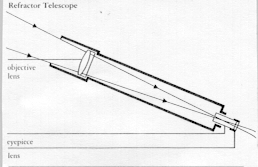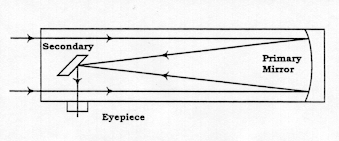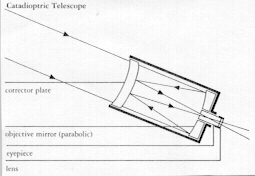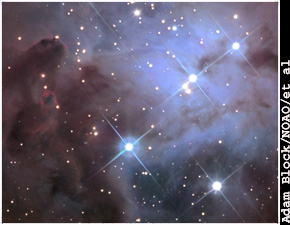|
Important Considerations
For the novice to the world of astronomy the first time stargazer might be confused about the various types and sizes of telescopes.
When you go to the local Wal*Mart you might see a cheap $69 dollar scope that says it can magnify up to 495 times. DON'T BUY
IT! The scope you may have thought about or may have already purchased is not very suitable for the adult beginner. These
telescopes tend to be poorly made and do not deliver a good image to the viewer. It is always important to buy what you can
afford but it is also important to buy something that you can get many nights of enjoyment from. There are several things
to take into consideration such as:
1. Aperature: The size of the lens at the front of the scope, the wider the lens
the more light that enters the scope, and thus the better image that you get.
2. Mount: Is the telescope on a altazimuth
(which basically is a up-down side-to-side mount), or a equitorial mount (which allows you to place one axis of the scope
twords the north star making it easier to track the stars as they move across the sky).
3. Type of scope: There are
three types of scopes that are most common which are the refractor, reflector, and catadioptric.
Keep reading to
learn more about all these considerations.
Types Of Telescopes
The first telescope we will discuss is the "refractor" (see fig. 1). the refractor works by using a lens to focus the
light to a point at the rear of the telescope where an eyepiece magnifys the image. The bettter of these telescopes offer
coated lenses which will correct many distortions of the image. The refractor is the most common and is well known because
its use in many of the old pirate movies, you know the old brass telescopes.
Second is the reflector (fig. 2) which uses
a mirror to focus the light back to a secondary mirror which sends the image to an eyepiece on the side of the scope. This
is the type Sir Isaac Newton used to first see the moons of Jupiter.
Third comes the least common and most expensive,
the Catadioptric (fig. 3) which uses a series of lenses and mirrors to focus the image at the rear of the scope. However this
is the most portable and can deliver the best image to the viewer for its size.
However, which ever type you choose you
should take a few things into consideration such as what will the telescope be used for, do you want easy transportability,
and do you want to spend a good deal of money.

A Simple Telescope
 
|
 |
|
|
|
 |
|
How To Start
For the beginner in astronomy there are many confusing terms. What does F5 mean? What is aperture? Well for the time
being we will start with a few things that will get you started into the hobby right away and try to stay away from the confusing
lingo.
The first timer may not understand that the first step for many is not running down to the store to buy a
telescope. For many the first step is as simple as going to the library and hitting the astronomy section. There are many
books there that the beginner can browse and take home and use in conjunction with one of the most important tools in astronomy.
The naked eye. It is a good idea to familiarize yourself with some of the basics of the night sky. You can learn the difference
between planets and stars and some of the basic constellations.
From there many people move to a good pair of binoculars
which will open more of the sky to you and let you see more detail and while you learn with the binoculars you can get ready
for the big step....your first telescope.

A Good Place To Start

fig. 1

fig. 2

fig. 3
How Telescopes Work
All telescopes work on the basis of gathering light produced by a star or the reflection of light by our own sun on things
like the Moon and planets. A lens or mirror concentrates this light at the eyepiece so that it can be magnified.
Light can be focused by a lens in the same way you can use a magnifying glass to burn ants on a sidewalk, or by using a mirror
similar to the kind used by many women that seems to enlarge your face, or slightly concave, meaning curved inward. The wider
the lens or the mirror the more light gathering ability it has (much the way the iris opens on your eye when it is dark,
so it can gather more light). The light is then focused at a point using a focusing knob so that the eyepiece can magnify
it. Eyepieces come in a varying amount of magnifying strenths to use for many situations and each one must be focused properly.
This is why the size of the lens or mirror (aperature) is so important, the better the light gathering ability the better
the image, and the higher the magnification you can use.
|
 |
|
|
|

